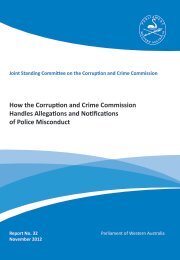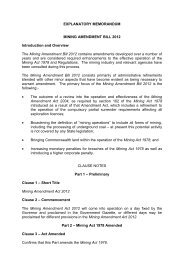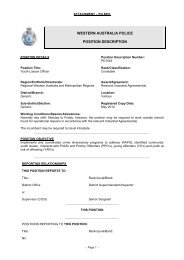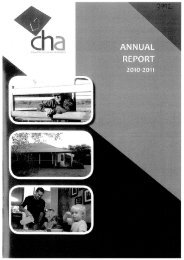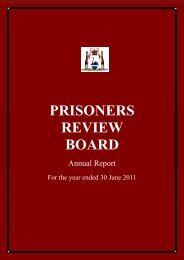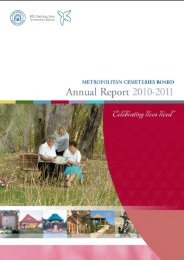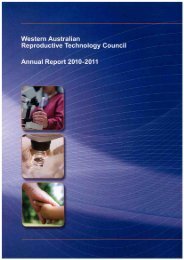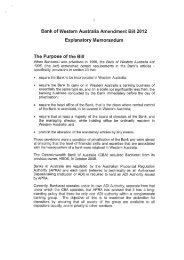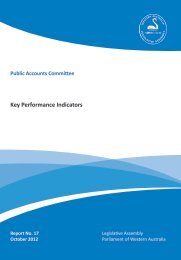Zoological Parks Authority - Parliament of Western Australia - The ...
Zoological Parks Authority - Parliament of Western Australia - The ...
Zoological Parks Authority - Parliament of Western Australia - The ...
You also want an ePaper? Increase the reach of your titles
YUMPU automatically turns print PDFs into web optimized ePapers that Google loves.
<strong>Zoological</strong> <strong>Parks</strong> <strong>Authority</strong> ANNUAL REPORT 2012<br />
Disclosures and Legal Compliance<br />
Financial Statements<br />
<strong>Zoological</strong> <strong>Parks</strong> <strong>Authority</strong><br />
Notes to the Financial Statements for the Year Ended 30 June 2012 continued<br />
(n) Amounts receivable for services (holding account)<br />
<strong>The</strong> <strong>Authority</strong> receives income from the State Government partly in cash<br />
and partly as an asset (holding account receivable). <strong>The</strong> accrued amount<br />
appropriated is accessible on the emergence <strong>of</strong> the cash funding requirement to<br />
cover leave entitlements and asset replacement.<br />
Refer note 19 ‘Income from State Government’ and note 23 ‘Amounts receivable<br />
for services’.<br />
(o) Inventories<br />
Inventories are measured at the lower <strong>of</strong> cost and net realisable value. Costs are<br />
assigned by the method most appropriate for each particular class <strong>of</strong> inventory.<br />
Retail shop inventory is measured on a weighted average cost basis.<br />
Inventories not held for resale are measured at cost unless they are no longer<br />
required, in which case they are measured at net realisable value.<br />
Refer note 21 ‘Inventories’.<br />
(p) Receivables<br />
Receivables are recognised at original invoice amount less an allowance for any<br />
uncollectible amounts (i.e. impairment).<br />
<strong>The</strong> collectability <strong>of</strong> receivables is reviewed on an ongoing basis and any<br />
receivables identified as uncollectible are written <strong>of</strong>f against the allowance<br />
account. <strong>The</strong> allowance for uncollectible amounts (doubtful debts) is raised<br />
when there is objective evidence that the <strong>Authority</strong> will not be able to collect the<br />
debts. <strong>The</strong> carrying amount is equivalent to fair value as it is due for settlement<br />
within 30 days.<br />
Refer note 2(k) ‘Financial Instruments’ and note 22 ‘Receivables’.<br />
(q) Payables<br />
Payables are recognised at the amounts payable when the <strong>Authority</strong> becomes<br />
obliged to make future payments as a result <strong>of</strong> a purchase <strong>of</strong> assets or services.<br />
<strong>The</strong> carrying amount is equivalent to fair value, as settlement is generally within<br />
30 days.<br />
Refer note 2(k) ‘Financial Instruments’ and note 27 ‘Payables’.<br />
76<br />
(r)<br />
Borrowings<br />
All loans are initially recognised at fair value, being the net proceeds received.<br />
Subsequent measurement is at amortised cost using the effective interest rate<br />
method.<br />
(s) Provisions<br />
Provisions are liabilities <strong>of</strong> uncertain timing or amount and are recognised where<br />
there is a present legal or constructive obligation as a result <strong>of</strong> a past event and<br />
when the outflow <strong>of</strong> resources embodying economic benefits is probable and<br />
a reliable estimate can be made <strong>of</strong> the amount <strong>of</strong> the obligation. Provisions are<br />
reviewed at the end <strong>of</strong> each reporting period. Refer note 28 ‘Provisions’.<br />
(i) Provisions – employee benefits<br />
All annual and long service leave provisions are in respect <strong>of</strong> employees’<br />
services up to the end <strong>of</strong> the reporting period.<br />
Annual leave<br />
<strong>The</strong> liability for annual leave that is expected to be settled within 12 months<br />
after the end <strong>of</strong> the reporting period is recognised and measured at the<br />
undiscounted amounts expected to be paid when the liability is settled.<br />
Annual leave that is not expected to be settled within 12 months after the<br />
end <strong>of</strong> the reporting period is recognised and measured at the present value<br />
<strong>of</strong> amounts expected to be paid when the liabilities are settled using the<br />
remuneration rates expected to apply at the time <strong>of</strong> settlement.<br />
When assessing expected future payments consideration is given to<br />
expected future wage and salary levels including non-salary components<br />
such as employer superannuation contributions as well as the experience <strong>of</strong><br />
employee departures and periods <strong>of</strong> service. <strong>The</strong> expected future payments<br />
are discounted using market yields at the end <strong>of</strong> the reporting period on<br />
national government bonds with the terms <strong>of</strong> maturity that match, as closely<br />
as possible, the estimated future cash outflows.<br />
<strong>The</strong> provision for annual leave is classified as a current liability as the<br />
<strong>Authority</strong> does not have an unconditional right to defer settlement <strong>of</strong> the<br />
liability for at least 12 months after the end <strong>of</strong> the reporting period.



